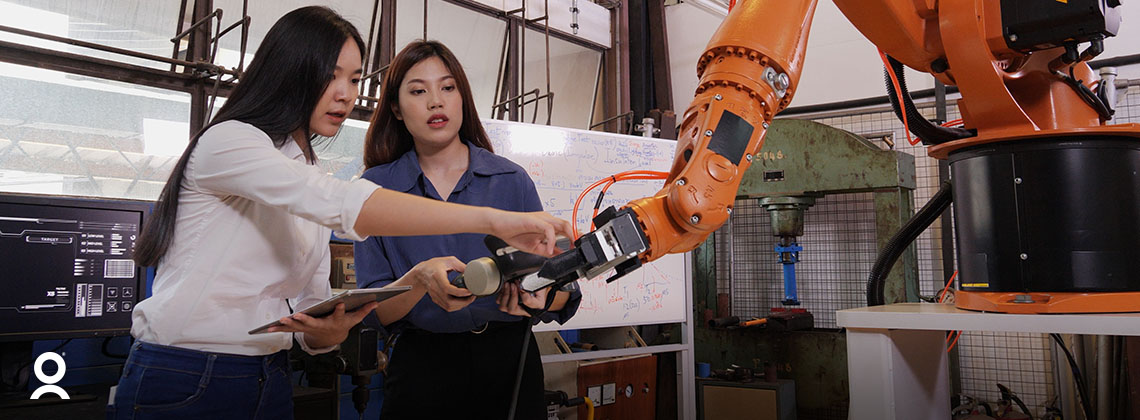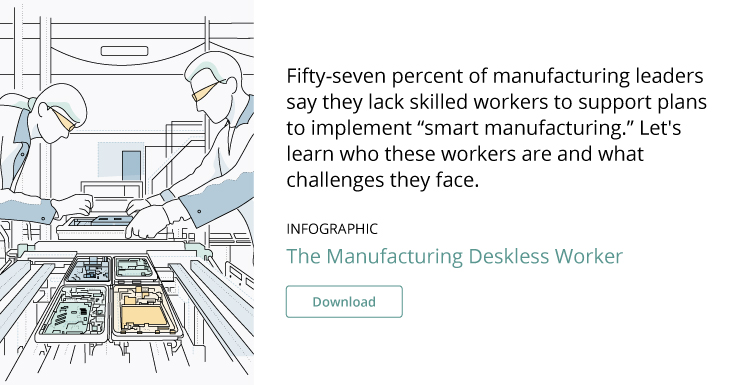Where Have All the Skilled Manufacturing Workers Gone?

Manufacturing is not only one of the most important industries in the world, but also in our culture. In fact, when many people think of the word “work”, they picture tools, assembly lines, and workers building products piece by piece. Think back to any classic cartoon or TV show of the 20th century and there’s bound to be at least one instance of that character working hard on a production line, be they Donald Duck, Lucille Ball, or Charlie Chaplin.
The manufacturing industry has changed immensely since then; it’s changed even more so in just the last 30 years. Where once hands and fingers fitted pieces together, now it’s often a complex machine guided by human touch. As you can imagine, a robot arm requires far more skill and training for a worker to operate than their own arms. But that necessary education can be a barrier to organizations looking to keep their factories operating efficiently.
As a result of the worldwide pandemic, when laborers have had to adapt to new regulations, options for remote opportunities in other fields, and turbulent changes to daily operations, many have chosen to leave manufacturing altogether. There is currently a worldwide shortage of manufacturing workers so big that it is believed there will be a jobs gap of 2.1 million positions by 2030. Where have all these workers gone?
Let’s take a look at some of the causes of this skilled labor shortage and discuss methods companies are using to fix it.
Inaccurate Negative Perceptions of Modern Manufacturing Jobs
Technology has transformed the manufacturing industry like no other. Unlike, for example, education, healthcare, or retail, which have retained core functions for centuries, manufacturing feels like it’s been completely reinvented every generation. From steam-powered presses to the robot arm, and the modern “Smart Factory”, frequent revolutions in processes can make the industry seem far more turbulent than it truly is.
There is also a perceived stigma associated with unions. The manufacturing industry is heavily unionized, and generations of arguments and politics have led to passionate feelings both against and in favor of the practice. While this article’s purpose is not to settle any ancient disagreements of generations of mudslinging between capital and labor, it is necessary to recognize how so much turbulence can lead an outsider to avoid the entire affair as “more trouble than it’s worth” and seek employment elsewhere.
While, yes, unions can be a complicated field to navigate, and yes, innovation has led to some workers losing their roles to automation, manufacturing is far more stable than some may believe. Skilled workers who can be trained in operating the necessary machinery of a modern “Smart Factory” are not only valued but are sorely needed. Moreover, as the pandemic has exposed weaknesses in the offshoring model, many factories are “reshoring”, moving productions back to communities they once helped build. The human element is alive, well, and crucial to production. Compensation, benefits, and room for advancement are available to workers willing to put in the time and effort.
Gap in Training / Skills
The changes in manufacturing over history have made it difficult for the public to form an accurate opinion. Despite the notion of factories employing “unskilled labor” being almost a century old (even the Industrial Revolution required workers educated in electricity, combustion, and communication), it persists, with some thinking an education would only be wasted in such a role. In fact, there is a massive gap between those properly trained and skilled, and positions that are badly awaiting workers to fill their roles.
Modern workforce management platforms (like The WorkForce Suite) can help fill these gaps with an emphasis on easing training for the common worker. Studies have found that most organizations implement training at the beginning of employment, or at such spaced out intervals as to be ineffective, and that most workers forget most of that training within six months. With proper technology between employer and employee, training can be communicated at any time, digitally, to ensure that workers have all the information they require, whenever and wherever the work is being done.
The gap in training skills is not a permanent or necessary one. Technology exists already to bring these workers the knowledge they need to fill these much-needed positions.
Employee Experience
One of the fears that keep workers as a whole from doing their best is feeling unheard by their employers. They worry, aside from the work itself, that these positions may involve constant conflict with supervisors. Images of hard-necked supervisors resembling Bruce Willis from the film “Armageddon”, treating every interaction with an employee as a confrontation, litter our popular media. Many are worried they are seen as “cogs in the machine”.
While that euphemism is more apt in manufacturing than others (seeing how many tasks include literal cogs and machines), the truth could not be more different. Manufacturing jobs are workplaces like any other, with rules and protocols to keep employees feeling like important parts of the overall organization. This has been accomplished through many technological innovations that allow workers to communicate with management digitally through their smartphones, where they have easy access to their employee data, scheduling information, communication channels with management, and much more. The goal of these platforms is to create a positive employee experience, making workers’ positions operate more smoothly and easing friction between labor and management. This keeps workers engaged, satisfied, and happy in their roles, leading to greater engagement and lesser turnover.
Though the gap between the number of skilled workers and the open positions that remain unfilled is large, the issue is not insurmountable. By making the most of digital technology (like The WorkForce Suite) within the modern smart factory model, workers can receive a more accurate, positive view on said roles, gain the training and skills necessary to excel, and achieve the best employee experience possible. Maybe soon our culture will start reflecting the new modern manufacturing position, and we’ll see a contemporary version of Lucille Ball on the assembly line with the digital tools to succeed, and also a mouthful of chocolates.
The skilled manufacturing worker will not be going extinct any time soon. This “endangered species” of labor is being replenished as we speak with new technology to support them in their roles, foster a better relationship with managers, and provide the much needed training to prepare them for their positions. Please read our Manufacturing Value Accelerator to get a glimpse of what modern workforce management can do for your workforce.
Subscribe to The WorkForce Blog
Learn the art and science of maintaining productive, happy, engaged employees.
Discover More
Nucleus Insights from WorkForce Customers Research Note
Nucleus Research interviews WorkForce customers who validate why we’re ranked the #1 WFM enterprise vendor for 10 consecutive years.
Elevate Employee Experience: Checklist for Operational Leaders
Get the practical steps and technology functionalities operation leaders need to improve their employees’ work experiences.
Streamlining Complex Workforce Compliance Requirements Boosts Productivity
Discover how workforce compliance software helps EMEA organisations navigate complex legislation, enhance compliance and boost operational efficiency.




